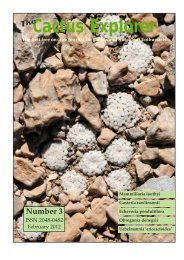Cactus Explorers Journal - The Cactus Explorers Club
Cactus Explorers Journal - The Cactus Explorers Club
Cactus Explorers Journal - The Cactus Explorers Club
You also want an ePaper? Increase the reach of your titles
YUMPU automatically turns print PDFs into web optimized ePapers that Google loves.
<strong>The</strong> <strong>Cactus</strong> Explorer ISSN 2048-0482 Number 4 May 2012<br />
Fig.5 Acanthocereus tetragonus at<br />
San Crisanto<br />
Fig.6 Acanthocereus tetragonus at<br />
San Crisanto<br />
beach side we could see an Agave growing in<br />
sandy ground. Both cerei were growing<br />
entangled in bushes, especially the<br />
Selenicereus. Only one Selenicereus was<br />
growing on a dead stem of an Agave and<br />
branches of this plant had a reddish colour,<br />
unlike the dark-green colour of stems of plants<br />
growing shaded by the bushes. <strong>The</strong> number of<br />
ribs of Acanthocereus tetragonus varied between<br />
three and five, but I saw one plant where a<br />
new shoot growing from the base of a dying<br />
stem had more than ten ribs. We had seen the<br />
same (or similar) Acanthocereus species at<br />
Uxmal.<br />
<strong>The</strong> Agave was later identified by Ms. Ivana<br />
Richter, the author of a 2011 book on agaves<br />
published in Italian and German by the Italian<br />
society AIAS, as Agave vivipara. <strong>The</strong>re was also<br />
a plant which resembled very much a South<br />
African Cotyledon with less succulent<br />
leaves(Fig.9). I have not been able to identify<br />
that one.<br />
Yucatán is also a major area for growing<br />
Agave for fibre. I was surprised to learn later<br />
that the plants grown for the sisal fibre are not<br />
Agave sisalana as the name would suggest but -<br />
A. fourcroydes, a sterile hybrid long called<br />
henequén by the Mexicans. It differs from A.<br />
sisalana by having slender, dark teeth spaced<br />
widely along the margin of the leaf. A. sisalana<br />
48<br />
Fig.7 Acanthocereus tetragonus at<br />
San Crisanto showing 2 growth forms<br />
has no teeth, or very minute ones. I suppose<br />
many of the plants and inflorescences we saw<br />
driving around Progreso belonged to these<br />
two Agaves. After all, Sisal, once an important<br />
port, lies only some 20 kilometres west of<br />
Progreso. Another plant we saw a number of<br />
times along the way was Opuntia dillenii with<br />
large pads, yellow flowers and huge (up to 10<br />
cm long and 6 cm wide) dark violet fruits.<br />
Having returned to Merida we made another<br />
attempt to find Mammillaria yucatanensis by<br />
driving east towards the Rio Celestún reserve<br />
on the western coast of the Yucatán penninsula.<br />
<strong>The</strong> reserve covers the estuary of Rio Celestún<br />
and protects mangrove vegetation as well as<br />
large flocks of flamingos, pelicans and many<br />
other birds. On the way to Rio Celestún and<br />
back we were driving through a dry (semideciduous?)<br />
forest of thin trees and tall bushes<br />
but during several stops we found neither the<br />
Mammillaria nor any other species of cacti.<br />
A few years after the trip I purchased ‘<strong>The</strong><br />
Cactaceae’ by Britton and Rose, a book I did<br />
not have access to when preparing for the trip.<br />
<strong>The</strong>re I read the original description of M.<br />
yucatanensis with the location given at<br />
Progreso and the note: "He (Dr. Gaumer) says<br />
that the plant is rare on the land side of the<br />
coastal marches". It is interesting that this vital<br />
information which appears just two lines




